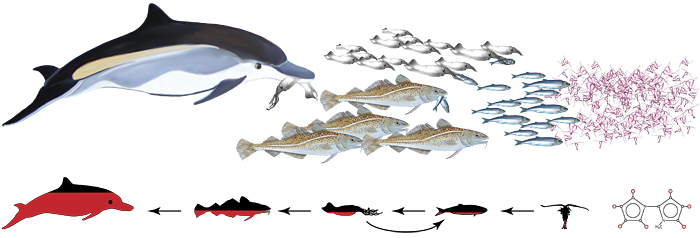Biomagnification Of Pollution In Bottlenose Dolphins
The North Atlantic Bottlenose Dolphins that reside in the Cape May, NJ waters are at the top of their food chain. With no viable predators, our dolphins are free to rule the waters, while consuming whatever they choose. As this may seem advantageous for our dolphins, it has actually become a serious health problem. Like all top predators, bottlenose dolphins are exposed to the greatest accumulation of marine pollution. This is the direct result of a process known as biomagnification. Once a pollutant enters the ocean, it gets carried up the food web, increasing in toxicity with every trophic level. This build-up of toxins leads to predators such as our own bottlenose dolphins to have among the greatest tissue concentrations of any species. The constant input of toxins into the ocean, not only directly effects our dolphins, but also indicates problems of our own.
Marine toxins are chemicals that pollute the water and all life within it, causing significant impacts within marine ecosystems. High concentrations have enabled major toxins to infiltrate entire marine trophic structures. Major marine toxic pollutants include mercury, PCBs (short for PolyChlorinated Biphenyls), pesticides, POPs (persistent organic pollutants), and other heavy metals. Although many metals occur naturally, the majority of harmful marine toxins are anthropogenic, or the result of human activity. Some of the greatest sources of toxins are factories, industries, sewage treatment plants, power plants, major manufacturers, oil drilling, and mining. Even individual sources of pollution, such as vehicle emissions and household chemicals, can accumulate to damaging quantities. Because water is such an effective solvent, the ocean easily absorbs vast quantities of toxic chemicals every day.
The effects of toxic chemicals on marine mammals continues to intensify each day. Marine mammals have been protected in the US under the Marine Protection Act of 1972, and yet total strandings are on the rise. Since bottlenose dolphins are mammals, they are considered to be among the most threatened of marine life for multiple reasons. Dolphins are of particular concern due the result of both bioaccumulation and biomagnification. Bioaccumulation is the buildup of toxin concentrations within an individual over time. Toxic pollutants bioaccumulate in dolphins through lactation, absorption through the skin or placenta, and respiration. This is further damaging due to their longevity, or long life span, their poor toxic elimination process, and their blubber. Once a toxin has become concentrated in a dolphin’s body, it has no effective way of cleansing. This is because a dolphin’s metabolism is unable to process pollutants at the rate at which they enter. Infiltrating chemical toxins typically store in fatty tissue, which would be their blubber. When a dolphin becomes stressed, it will break down its blubber to obtain stored energy. During this process, built-up toxins become released, flooding the dolphin’s body with poison.
The primary result of pollutant bioaccumulation is through biomagnification, which arises from the consumption of prey. Toxic pollution is first introduced through the ingestion of microbes. It then continues up the food web, with each successive trophic level having about 10 times greater concentrations than the last. Since our bottlenose dolphins hold such a high position within the food web, this means that they comprise of approximately a million times more toxic pollutants than their surrounding waters.
Because dolphins have such high concentrations of pollution, their health effects are among the most severe. Bottlenose dolphins, especially residential pods of the east coast, have recently shown extraordinary levels of toxins in their blubber, skin, and blood. Such exposure to toxic pollution suppresses their immune systems, leaving them highly susceptible to infections and disease. Toxic pollutants have been directly correlated to many health issues in dolphins, including cancer, developmental and genetic deformities, lowered fertility rates, neurological, renal, hepatic, cellular, and endocrine defects. In Cape May, NJ, hepatic panels have found that many of our own residential dolphins have impaired liver function. Studies have found that dolphins with the greatest bioaccumulations suffer physiological and behavioral changes, and even decreased life expectancies. The results of the biomagnification of toxic pollution in dolphins is even believed to have a major influence on the number of mass strandings and mortalities.
Not only do toxic pollutants effect the well-being of our dolphins that we have come to know and love, but our own health as humans. As harmful as pollution is to dolphins, they do serve as the greatest sentinels of how toxic our environment and food sources are to us as well. As humans and dolphins are both mammals, with similar ecologies, anatomies, long lifespans, and diets, the health of our dolphins is a direct correlation to our own. Because of these relations, many diseases that result from toxic exposure in dolphins can also be experienced by humans. Unlike humans, dolphins are constantly exposed to poor water qualities and toxic contamination at all times. This constant, direct exposure qualifies dolphins as a sentinel species for humans, warning us of the health risks we are currently facing.
Bottlenose dolphins, such as the ones we visit daily on our whale watching cruises, are so important in many ways. Dolphins are a necessity in keeping a balanced food web and healthy ecosystem. Perhaps equally important to observers such as myself, is to be able to view happy, healthy dolphins as frequently as we do today in our Cape May waters. Unfortunately, without minimizing the constant threat of toxic pollutants, this may not be a guarantee for the future.
-Lisa Kosilla, University of Hawaii at Hilo, Intern at Cape May Whale Watch and Research Center
Sources
Jones, Hardy, and Ted Danson. (2007). A Shared Fate. Retrieved July 15, 2016, from http://www.bluevoice.org/webfilms_sharedfate.php
Sotka, C., Lubchenco, J., Schwacke, L., Venn-Watson, S., Ramsdell, J., Nollens, H., & Rowles, (2010, February 18). Dolphins’ Health Shed Light on Human and Ocean Health. NOAA. Retrieved July 15, 2016, from http://www.noaanews.noaa.gov/stories2010/20100218_dolphins.html Toxic Pollution.
Toxic Pollution. (2016). Retrieved July 15, 2016, from http://www.seaweb.org/resources/briefings/toxic.php
WDC. (2016). Marine Chemical Pollution. Retrieved July 15, 2016, from http://us.whales.org/issues/marine-chemical-pollution


